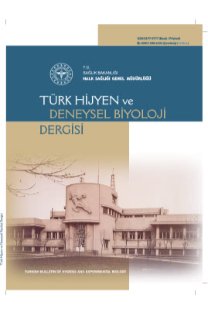Ankara Numune Eğitim ve Araştırma Hastanesinde Hastane Enfeksiyonu Etkeni Olarak İzole Edilen Candida Suşlarının Dağılımı 2010-2015
nozokomiyal enfeksiyon, Candida türleri, kandidemi, epidemiyoloji
Distribution of Candida species isolated from Nosocomial infections of Ankara Numune Training and Research Hospital 2010-2015
nosocomial infection, Candida species, candidemia, epidemiology,
___
- 1. Eggimann P, Que YA, Revelly JP, Pagani JL. Preventing invasive candida infections. Where could we do better? J Hosp Infect, 2015; 89 (4): 302-8.
- 2. Kauffman CA. Fungal Infections. Proc Am Thorac Soc, 2006; 3 (1): 35-40.
- 3. Khan ZU, Chandy R, Metwali KE. Candida albicans strain carriage in patients and nursing staff of an intensive care unit: a study of morphotypes and resistotypes. Mycoses, 2003; 46 (11-12): 479-86.
- 4. Tiraboschi IN, Bennett JE, Kauffman CA, Rex JH, Girmenia C, Sobel JD et al. Deep Candida infections in theneutropenic and on-neutropenic host: an ISHAM symposium. Med Mycol, 2000; 38(1): 199- 204.
- 5. Brown GD, Denning DW, Gow NA, Levitz SM, Netea MGWhite TC. Hidden killers: human fungal infections. Science translational medicine, 2012; 4(165): 165rv13.
- 6. Vincent JL, Rello J, Marshall J, Silva E, Anzueto A, Martin CD, et al. International study of the prevalence and outcomes of infection in intensive care units. JAMA, 2009; 302 (23): 2323-29.
- 7. Pfaller MA, Castanheira M. Nosocomial Candidiasis: Antifungal Stewardship and the Importance of Rapid Diagnosis . Medical Mycology, 2016; 54(1): 1-22.
- 8. Horan TC, Andrus M, Dudeck MA. CDC/NHSN surveillance definition of healthcare-associated infection and criteria for specific types of infections in the acute care setting. Am J Infect Control, 2008; 36(5): 309-32.
- 9. Fridkin SK, Jarvis WR. Epidemiology of nosocomial fungal infections. Clin Microbiol Rev, 1996; 9(4): 499-511.
- 10. Horasan EŞ, Ersöz G, Göksu M, Otag F, Kurt AO, Karaçorlu S.ve ark. Increase in Candida parapsilosis fungemia in critical care units: a 6-years study. Mycopathologia, 2010; 170(4): 263-8.
- 11. Otağ F, Aslan G, Şen S, Özturhan H, Emekdaş G. 2003-2005 süresinde klinik örneklerden izole edilen maya türlerinin değerlendirilmesi. Infeks Derg, 2005; 19:435-43.
- 12. Pfaller MA, Castanheira M, Messer AS, Moet GJ, Jones RN. Variation in Candida spp. distribution and antifungal resistance rates among bloodstream infection isolates by patient age: report from the SENTRY Antimicrobial Surveillance Program (2008- 2009). Diagn Microbiol Infect Dis, 2010; 68(3): 278- 83.
- 13. Kibbler CC, Seaton S, Barnes RA, Gransden WR, Holliman RE, Johnson EM. et al. Management and outcome of bloodstream infections due to Candida species in England and Wales. J Hosp Infect, 2003; 54(1): 18-24.
- 14. Vincent JL, Bihari DJ, Suter PM, Bruining HA, White J, Nicolas-Chanoin MH, et al. The prevalence of nosocomial infection in intensive care units in Europe. Results of the European Prevalence of Infection in Intensive Care (EPIC) Study. EPIC International Advisory Committee. JAMA, 1995; 274(8): 639-44
- 15. Bougnoux ME, Kac G, Aegerter P, d’Enfert C, Fagon JY; CandiRea Study Group. Candidemia and candiduria in critically ill patients admitted to intensive care units in France: incidence, molecular diversity, management and outcome. Intensive Care Med, 2008; 34(2): 292-9
- 16. Comert F, Kulah C, Aktas E, Eroglu O, Ozlu N. Identification of Candida species isolated from patients in intensive care unit and in vitro susceptibility to fluconazole for a 3-year period. Mycoses, 2006; 50(1): 52-7
- 17. Erdem F, Tuncer Ertem G, Oral B, Karakoç E, Demiröz AP, Tülek N. Epidemiological and microbiological evaluation of nosocomial infections caused by Candida species. Mikrobiyol Bul, 2012; 46(4):637-48.
- 18. Pfaller MA, Diekema DJ, Newell VA, Ellis D, Tullio V, Rodloff A. Results from the ARTEMIS DISK Global Antifungal Surveillance Study, 1997 to 2007: a 10.5- Year Analysis of Susceptibilities of Candida Species to Fluconazole and Voriconazole as Determined by CLSI Standardized Disk Diffusion. J Clin Microbiol, 2010; 48(4): 1366–1377.
- 19. Phaller MA, Jones RN, Doern GV, Sader HS, Messer SA. International surveillance of bloodstream infections due to Candida species: frequency of occurrence and antifungal susceptibilities of isolates collected in1997 in the United States, Canada and South America for the SENTRY program. J Clin Microbiol, 1998; 36 (7): 1886-9.
- 20. St-Germain G, Laverdie M, Pelletier R, A.- M. Bourgault, M. Libman, C. Lemieux, et al. Prevalence and antifungal susceptibility of 442 Candida isolatesfrom blood and other normally sterile sites: results of a 2-year (1996 to 1998) multicenter surveillance study in Quebec, Canada. J Clin Microbiol, 2001; 39(3): 949-53.
- 21. Acar A, Oncul O, Kucukardalı Y, Ozyurt M, Haznedaroğlu T, Cavuşlu Ş. Yoğun bakım unitelerinde saptanan Candida enfeksiyonlarının epidemiyolojik özellikleri ve mortaliteye etki eden risk faktorleri. Mikrobiyol Bul, 2008; 42(3): 451-61.
- 22. Snydman DR. Shifting patterns in the epidemiology of nosocomial Candida infections. Chest, 2003; 123 (5 Suppl): 500-3.
- 23. Guinea J. Global trends in the distribution of Candida species causing candidemia. Clin Microbiol Infect, 2014;(20): 5-10.
- 24. Pfaller MA, Diekema DJ. Epidemiology of invasive candidiasis: a persistent public health problem. Clin Microbiol Rev, 2007; 20(1): 133–163.
- 25. Yapar N, Pullukcu H, Avkan-Oguz V, Sayin-Kutlu S, Ertugrul B, Sacar S, et al. Evaluation of species distribution and risk factors of candidemia: a multicenter case-control study. Med Mycol, 2011; 49(1): 26-31.
- 26. Bakir M, Cerikcioglu N, Barton R, Yagci A. Epidemiology of candidemia in a Turkish tertiary care hospital. APMIS, 2006; 114(9): 601-10.
- 27. Adiloğlu AK, Şirin MC, Cicioglu-Arıdoğan B, Can R, Demirci M. Çeşitli klinik örneklerden izole edilen Candida kökenlerinin identifikasyonu ve antifungal duyarlılıklarının araştırılması. ADÜ Tıp Fak Derg, 2004; 5(3):33-6.
- ISSN: 0377-9777
- Yayın Aralığı: 4
- Başlangıç: 1938
- Yayıncı: Türkiye Halk Sağlığı Kurumu
Serap SÜZÜK, Banu KAŞKATEPE, Havva AVCIKÜÇÜK, Laser SANAL, Gül ERDEM, Nilay ÇÖPLÜ
Hüseyin İLTER, Derya ÇAMUR, Murat TOPBAŞ
Efsun AKBAŞ, Nilay ÇÖPLÜ, Hüsniye ŞIMŞEK, Berrin ESEN, Berna SEZGIN
